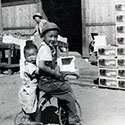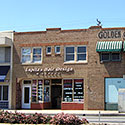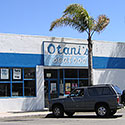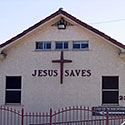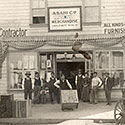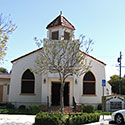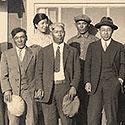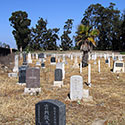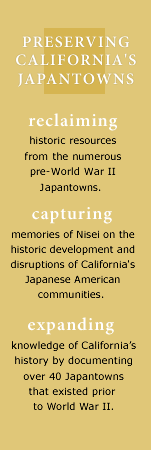 |
OxnardWith sugar beets becoming Oxnard’s principal crop, The American Beet Sugar Company, privately owned by the town’s namesake family, was incorporated in 1899. Demand for laborers followed the factory’s establishment, and drew 1,000 Japanese farm workers to harvest the sugar beets and live in a "tent city" near the fields. Language and cultural barriers caused the Japanese to rely on the labor contractors to find jobs and serve as intermediaries with their employers. With poor working conditions, low wages, and exploitation by the contractors, tensions mounted. In 1903, the historic strike of the Japanese-Mexican Labor Association (JMLA) was the first large multi-ethnic agricultural labor strike in California. Led by Kusaburo Baba, JMLA comprised of 500 Japanese and 200 Mexican workers, threatened the monopoly of the company-sponsored labor contracting business, Western Agricultural Contracting Company (WACC). Within a month, JMLA grew to represent 1,200 workers or 90 percent of the labor force on strike, causing the WACC to disband. While the strike and labor shortage that followed quelled the immediate unrest, unfair labor resumed and confrontations arose. A few months later, a bullet, a reminder that he was no longer welcome in town, grazed John Inose, the Japanese spokesperson for WACC, when sighted at a local bathhouse. In the first century, Oxnard’s Japantown concentrated on Saviers Road (later named Oxnard Blvd) between 4th and 8th Streets with several billiard halls as the main recreation catering to the bachelor community, along with general stores, rooming house, barber, cleaners, and restaurants. A decade later, the Japanese businesses expanded to Seventh Street. With the arrival of women and the birth of children in the 1920s, Oxnard’s Japantown, like communities elsewhere, took on a more permanent character, with the addition of churches, language schools and residences. ›› CLICK TO ENLARGE.
PROFILES
| ||||

With the sugar beet harvest as seasonal work, Japanese laborers, referred to as buranke katsugi (blanket carriers) for moving camp to camp with their blankets, were contracted to other areas to pick fruit, dig potatoes, and harvest a variety of crops. By the mid-1930s, Issei immigrants in Oxnard began vegetable production that was shipped to the Los Angeles market. Oxnard Noson Shinyo Kumiai (Agricultural Credit Association) was formed in 1937 to facilitate the shipment of green tomatoes out of state, and to create a cooperative purchasing system for fertilizer, crates and other supplies. By 1940, there were approximately 40 Japanese farms with 1,500 acres yielding a variety of produce, such as cauliflower, cabbage, celery, cucumbers, bell peppers, tomatoes, lettuce, peas, and carrots. In an article addressing the impact of the evacuation to Ventura County, the president of the Ventura County Farm Bureau stated, "The produce production in the county has become increasingly important in recent years. We hope this Japanese labor can be supplanted." The image above shows two children at play in front of the tomato packing sheds on the Kato family farm. Photo courtesy of S. Kato Collection, Oxnard Public Library - Main Library, Oxnard Digital Heritage Room

To support the growing population of laborers, several Japanese businesses were organized shortly after the turn of the century. American Mercantile Company, formed in 1902 by five partners, with only one being Japanese - John Inose, who later worked with WACC, the organization that the labor strike protested against the following year. The Japanese Contracting Company was incorporated to support the large agricultural labor force in the county
Asahi Company, depicted above was formed in 1907 by several partners who established a grocery store, labor contract agency, and boarding house. Shingoro Takasugi became the sole proprietor of Asahi Market in the 1920s until the forced evacuation in 1941. During WWII, he leased the business to a Mexican American family who took great care of the property and remained dear friends after the war. The Takasugi family resumed the business after the war and replaced the vulnerable wood frame building with a brick structure in 1956. Forced to leave his studies at UCLA prior to the war, Nao Takasugi continued his education on the east coast and returned with a Masters in Business Administration from Wharton College, before joining the family business. He later served for several years on various city agencies, including the City Council, ten years as Mayor of Oxnard, and six years for the California State Assembly before his retirement. Asahi Market has remained in operation as a grocery store for over a century and continues today under new proprietorship. Photo courtesy of Takasugi Collection, Oxnard Public Library - Main Library, Oxnard Digital Heritage Room.

From the early 1910-30s, this site housed Matsumoto Barber and Billiards, then Fuji Barber and Bath in the 1940s prior to the war. As reflected in the change of business at this site, Oxnard's Japantown initially catered to the population of immigrant bachelors, offering five billiard establishments as a source of recreation during the early years, three billiard halls in the late 1920s, and by the late 1930s, the halls had disappeared. As the Japanese settled into farming and the raising of families, new businesses included fish stores, fruit markets, and retail shops. Lupita Hair, a salon catering to the predominantly Hispanic community in Oxnard, now occupies the former site.

In the same year that Oxnard was incorporated as a city in 1903, the Japanese established the Methodist Mission Church. With concern for the spirit and behavior of the young immigrant laborers that toiled in the fields all day and communed in the billiard halls at night, Kusaburo Baba, a labor contractor and deeply committed Christian, organized the Japanese Christian Young Peoples' Society with the aid of Rev. J. H. Avery of St. Paul Methodist Episcopal Church. The church soon became the heart of the community, offering English language classes and religious study. The first church building at 632 A Street was dedicated in 1908. In addition to leading the laborers to form the JMLA and stage a strike in 1903, Baba launched an anti-tobacco crusade in Oxnard in 1909, which enraged Chinese tobacco store owners and intimidated Japanese patrons. Baba first served as a lay leader for the Methodist Church, but later studied to become a minister. The church congregation has joined with St. Paul's Methodist Church and continues to offer Japanese language ministry.

Otani Company dates back to 1908 when Toraichi Otani operated a general store and barbershop at 620 Oxnard Blvd, on the first floor of the building. Other businesses included a pool hall and small bathhouse. The family lived on the building's second floor. Decades later, the Nisei sons opened Otani Brothers Produce just prior to the forced removal and evacuation of all Japanese Americans living on the west coast during WWII. Otani Company was boarded up, family belongings were stored in a bedroom, and the house was leased to a Filipino and Mexican American couple, who faithfully paid the mortgage and watched over the properties. After the war, the three Nisei brothers set up a malt shop, specializing in American fare, such as avocado cheeseburgers, fried baloney sandwiches, ice cream sundaes and banana splits; and featuring a jukebox. Sold in the mid 1950s, La Pizza Loca is the current business at the historic site.
In 1952, Izuto Otani started his own venture, building Otani Fish Market at 610 South A Street. In addition to selling fish, the store offered Japanese foods, and fishing tackle supplies. By 1972, a fish & chips shop was featured and has been a mainstay ever since. Continuing the family know-how in adapting business to community needs, the fourth generation operates Otani Izzy Fish Market and Restaurant today. In step with the recent revitalization of old town, the restaurant offers a no-fuss dining experience with specialties such as the classic Fish & Chips, clam chowder, grilled red snapper, or tempura. Otani is the last remaining pre-WWII Japanese American business in town.

For recreation and sport, Issei entrepreneur Mr. Kubota built a pier at Point Mugu and established a Fish Camp in the 1920s. Attracting eager Japanese fishermen, the Issei would gather at the pier to be taken by launch to a barge for a day of fishing. Fish Camp became a popular spot for picnic and outings for the Japanese in Oxnard. Mr. and Mrs. Kubota appear in the back row of the 1931 photo. Photo courtesy of Moriwaki Collection, Oxnard Public Library - Main Library, Oxnard Digital Heritage Room.

In affiliation with the Los Angeles Hompa Hongwanji Buddhist Temple, Japanese Buddhists would gather in homes for religious services in the late 1920s. Following the establishment of Showa Gakuen at 6th and C in 1927, the Buddhist services soon moved to the school site and fundraising began for the building of a temple. By 1929, the new temple at 234 E. Sixth Street was dedicated. To accommodate the growing community, a social hall was built on an adjacent lot in 1939. Shortly thereafter during WWII, the church temple and social hall were used to store belongings of church members; and the minister's residence was rented by the Manuel Pena family.
After the war, the Buddhist church served as a hostel for returning families for nearly ten years due to the economic hardship and hostile climate in the area. Through the impetus of new Japanese families moving in to the area, the church finally began to reorganize its Sunday School and activities, hosting its first Obon Festival in 1956. In 1964, the Buddhist Church decided to purchase property owned by St. John's Lutheran Church and moved to its current site at 250 South H Street in 1966. The former temple was sold to the Santa Barbara Rescue Mission in 1972, enabling the church to retire their mortgage at the new site. The Oxnard Buddhist Church continues as a center of religious, social and cultural activity for the Japanese community today in Ventura County.

On a triangular piece of land at the edge of town, past the newly developed Oxnard Community College, is the forlorn site of the Oxnard Japanese Cemetery. Originally segregated from the main grounds by a grove of trees, the one-third acre plot, owned by the Hueneme Masonic Cemetery Association, contains approximately 140 graves of former Japanese residents of Oxnard who were buried from 1907 through the 1960s. At its height, the cemetery entrance contained a large wooden Japanese torii-style gate and elaborate headstones with names in Japanese characters or English carved into the granite. Unfortunately, many of the markers prior to the establishment of the Buddhist Church in 1920, do not have dates or records; and the headstones destroyed through neglect and vandalism have been replaced by obelisk-shaped 4x4 wooden posts painted white. Nearly all the families of the deceased buried at the site no longer live in Oxnard.
Many others have moved the remains of family members to Ventura's Ivy Lawn Memorial Cemetery or sent them to Japan. Although community volunteers provide maintenance work and a Buddhist memorial ceremony is conducted annually, the grounds have deteriorated and weeds have overtaken the lot. In 1971, the Oxnard Japanese Cemetery was declared Ventura County Cultural Heritage Landmark #18, recognizing its important history to the region.
